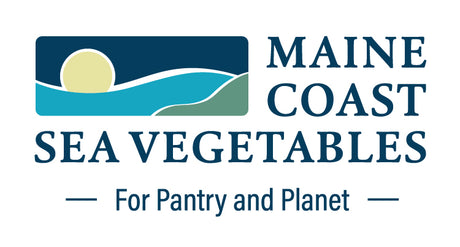Seaweed Nutritional Facts
Dried seaweed is a nutritional powerhouse. Sea vegetables contain most or all of the 24 minerals and trace elements necessary for your body's physiological functions, some in quantities greatly exceeding those of land plants. They contain significant levels of vitamins, including the B vitamins, Vitamin A, and Vitamin C. Their protein content ranges from 10% to almost 40%, and seaweed protein is usually a complete protein, meaning it contains all nine essential amino acids required by humans. Sea vegetables are low in fat and high in fiber; two qualities that make them healthy for the heart. And then, of course, there’s iodine. Sea vegetables are one of the highest natural sources of dietary iodine, even when eaten in small quantities.
Below are two tables showing the levels of macro and micro nutrients found in our eight sea vegetable species, blends, and Kelp Krunch. Milled sea vegetables have the same nutritional composition as the whole leaf from which they were milled. For example, dulse flakes have the same nutritional composition as whole leaf dulse. The levels in these tables are provided as “amounts per 100g” because this is how the information is normally presented for food industry specifications, but 100 grams is not a serving size! You can use these tables to compare levels between species and products and to calculate how much of a particular nutrient there is in a serving of any size. All you need is a calculator and some simple math: divide the level of the nutrient listed in the table by 100 to get the level per gram, and then multiply that by the number of grams in your serving.
The below tables represent average compositions based on published research articles and our own testing. Some species lack published data for certain nutrients and we have not yet tested for those nutrients. Those cases are indicated by “NA” (Not Available). It’s important to bear in mind that sea vegetables are wild marine plants and their nutritional composition naturally fluctuates due to location, season, tidal flows, ocean temperatures, weather patterns, and other factors. The values presented here are not absolutes, and we believe the whole algae provide more than the sum of their parts. (You may double click on the table in order to view larger.)
Seaweed Nutritional Facts By Species
Click here for a larger version

Serving Size
To paraphrase an old saying, oftentimes good things come in small portions. This is definitely true of sea vegetables. The nutrients in dried sea vegetables come in a concentrated form, so you don’t have to eat much to get the most from them. Even in Japan, where about one-third of the adult population eats seaweed almost every day, the average daily intake is only about 4-7 grams, usually over the course of 2-3 small servings eaten throughout the day. In the US, the FDA defines a serving size as the amount customarily consumed at one meal, or the “Reference Amount Customarily Consumed” (RACC). The FDA considers 5 grams to be the RACC for dried seaweed. However, this is for whole leaf. Milled seaweed such as flakes, granules, and powders is usually eaten in smaller quantities of 1-3 grams. The serving size is required information on nutrition facts labeling because it informs consumers about the nutritional value of their food in a quantifiable fashion. It shouldn’t be interpreted as the amount one is supposed to eat, but rather as the amount that most people typically eat.
We’ve learned through experience and from our customers that how much people eat very much depends on the product form and how it’s used. Sea vegetable flakes, granules and powders are usually used in small amounts to add flavor and nutrition to such things as soups, dips, or smoothies. Whole leaf sea vegetables, on the other hand, may be eaten as snacks or used as ingredients in salads or casseroles, much as one might add arugula or other greens to a mixed salad, or spinach to a lasagna.
The below table shows the serving size for most Maine Coast Sea Vegetable products, along with levels of the three essential minerals required on the nutrition label, plus iodine (nutritional values are rounded to nearest whole number).
Typical Sea Vegetable Serving Sizes Showing Essential Minerals and Iodine Per Serving
Click here for a larger version


